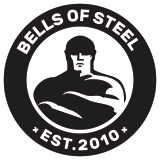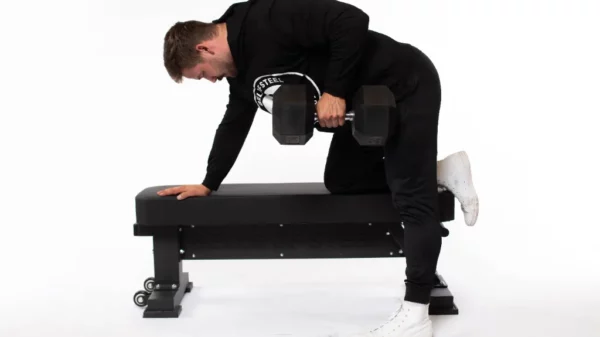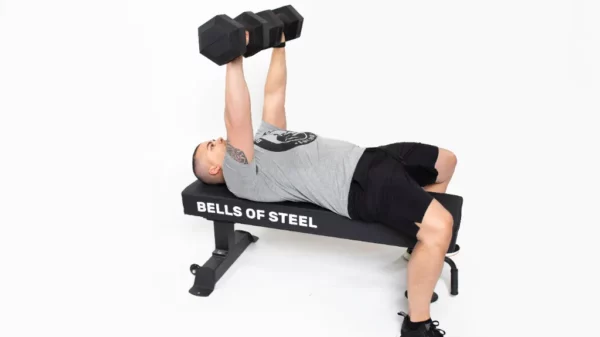The Bells of Steel Safety Squat Bar (SSB) came into my life because of my clients’ need for it. They needed a bar that would help them squat with a bar on their back comfortably (as comfortable as a back squat can be). And BoS had one that fit the bill. It was affordable, well made and their videos on using it showed that they cared about the people buying it. It warmed my heart. I was sold.
This article is about how to use a Safety Squat bar properly, and its main benefits.
The Safety Squat Bar makes squatting possible for most athletes, and yes even the less mobile ones.
Tight chest, shoulders and inflexible wrists? This bar has you covered.
If you’re a veteran of strength training, you might already know that putting the bar on your back for back squats is not always comfortable and for some – it’s just not possible.
Enter the Bells of Steel Safety Squat Bar.
How to Use the Safety Squat Bar: Reasons to Love it

The people behind this bar made it comfortable (hello, padding galore), and user-friendly. Even my tightest client uses it and loves that he can use this without straining his immobile shoulders.
We had already exhausted dumbbell variations of squatting, and since he is hella strong – I knew this bar would help him up his squat game.
This bar will not only be helpful to those with limited shoulder and wrist mobility but it will up your quad training regime too. If you’re like me and your quads need a little extra help — this bar could be a game-changer for you.
Not only is the SSB helping to fire up your quads, but your hamstrings and glutes are going to get to work, as well. And depending on what handles you choose to use (depending on your level and focus for your training session) – your core will get lit up as well.
How to Use a Safety Squat Bar: Some things to remember
The weight of this bar is a little more than your traditional Olympic Bar, so start with a weight that is a little lighter to get a feel for it.
If you’re doing back squats – you’re going to feel like you’re leaning a little forward in these, and it’s probably because you are! The bar should sit on the shelf of your shoulders, and your hands should grip the handles to create some tension as you sit into your squat. This is an important point to remember when using a Safety Squat Bar.
How to Use a Safety Squat Bar vs Barbell
The basic differences between how to use a safety squat bar and an Olympic barbell come down to where you place your hands. Oh, and yes – the padding. The padding makes a big difference in comfort.

For your traditional back squat with an Olympic barbell, your hands are placed outside your shoulders, but you need to have mobile shoulders and wrists to get your hands in this position.

For the SSB, the bar is on your back and your hands are out in front of you – using one of three handle options.
If you are tight in the front of your body due to lifestyle or your job – the SSB will allow for a better hand position without the strain on your joints that you may feel with the Olympic barbell.
In terms of weight, the SSB weighs in at 58 lbs vs. the Olympic Barbell which is 44 lbs.
The padding and curved shape of the SSB make it a beast to move around and allows you to squat with ease as a novice or seasoned lifter.
How else can you use the Safety Squat Bar
Using it for a back squat is not the only way to make use of the Safety Squat Bar – it’s a great alternative for front squats too. Getting the Olympic barbell in that front rack position is, well, tricky and for some, it just may not happen. The SSB makes front squatting possible, and adds to the reasons why we love it.
But your love for this handy little bar doesn’t have to stop here. You can use it for Good Mornings, Reverse Lunges, Split Squats and all of its lovely (…terrible) variations too.
And let’s not forget that you can target the upper body too with several exercises.

The SSB comes with several different attachments – your traditional handles where your hands are close to your body (this is probably the most common), longer handles for a more relaxed feel with your hands away from your body and chains for the more advanced and those looking for a less stable version.
What the Safety Squat Bar is NOT used for
I hate to say it, but the SSB can’t be used for everything.
Deadlifts, Barbell Rows or any Olympic lifting moves are just three that come to mind where you cannot use the SSB.
But, not to worry – Bells of Steel has an awesome bar to change up your deadlifts: the Bells of Steel Open Trap Bar.
How to Use a Safety Squat Bar Summary
If you have mastered the technique of a squat, and you can bear the weight of the bar on your shoulders – then yes! I have several clients of varying ages that are using the bar successfully – especially if they have tight shoulders, wrists and/or elbows.
The SSB is a great tool for adding weight to your squat without unnecessarily straining your upper body to get into the position of a traditional back squat.
I love it and my clients love it.
For me, this bar is a win. This is my first SSB, and Bells of Steel makes all of its features (padding, extra handles and quality) a well worthwhile purchase.
If you’ve made it this far – thank you for reading how to use a safety squat bar.
If you’re thinking about getting the SSB – you won’t regret it. I hope this helped you to better understand how this bar can change your life. Ok…well, maybe just your squats.
Lift on.
This is a guest blog by Catherine Swail, PTS, BA. BEd. She is an online trainer, performance stretch therapist and soft tissue mobilization practitioner. Find out more about her by visiting her website at Reborn Catherine Fit.








